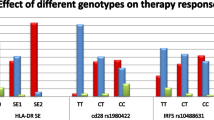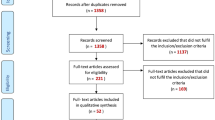Abstract
We investigated whether killer cell immunoglobulin-like receptor (KIR) genes are risk factor(s) for rheumatoid arthritis (RA) and its clinical manifestations. One hundred and seventy-seven RA patients and 243 healthy individuals were tested for the presence of 11 KIR genes using PCR-SSP method. The frequencies of KIRs in patients with RA were similar to the frequencies in controls. However, RA patients positive for KIR2DL3 and negative for KIR2DS3 had earlier disease diagnosis. Additionally, KIR2DL2 and KIR2DS2 were significantly more frequent among RA patients with extra-articular manifestations and in its subgroup with vasculitis than in controls and in patients without these complications. Furthermore, the frequencies of KIR2DS1 and KIR3DS1 were lower in patients without bone erosions compared with healthy individuals. Relationships between the presence or absence of autoantibodies (rheumatoid factor and anti-cyclic citrullinated peptide) and KIR frequencies were also evaluated, but no significant differences were observed. These results suggest that particular clinical manifestations of RA may have different genetic backgrounds with respect to KIR genotype.
This is a preview of subscription content, access via your institution
Access options
Subscribe to this journal
Receive 6 digital issues and online access to articles
$119.00 per year
only $19.83 per issue
Buy this article
- Purchase on SpringerLink
- Instant access to full article PDF
Prices may be subject to local taxes which are calculated during checkout
Similar content being viewed by others
References
Lee DM, Weinblatt ME . Rheumatoid arthritis. Lancet 2001; 358: 903–911.
Symmons DPM . Epidemiology of rheumatoid arthritis: determinants on onset, persistence and outcome. Best Pract Res Clin Rheumatol 2001; 16: 707–722.
MacGregor AJ, Snieder H, Rigby AS, Koskenvuo M, Kaprio J, Aho K et al. Characterizing the quantitative genetic contribution to rheumatoid arthritis using data from twins. Arthritis Rheum 2000; 43: 30–37.
Dalbeth N, Gundle R, Davies RJO, Lee YCG, McMichael AJ, Callan MFC . CD56bright NK cells are enriched at inflammatory sites and can engage with monocytes in a reciprocal program of activation. J Immunol 2004; 173: 6418–6426.
Falgarone G, Jaen O, Boissier MC . Role for innate immunity in rheumatoid arthritis. Joint Bone Spine 2005; 72: 17–25.
Linsen L, Thewissen M, Baeten K, Somers V, Geusens P, Raus J et al. Peripheral blood but not synovial fluid natural killer T cells are biased towards a Th1-like phenotype in rheumatoid arthritis. Arthritis Res Ther 2005; 7: R493–R502.
Vilches C, Parham P . KIR: diverse, rapidly evolving receptors of innate and adaptive immunity. Annu Rev Immunol 2002; 20: 217–251.
Carrington M, Norman P . The KIR Gene Cluster. National Library of Medicine (US), National Center for Biotechnology Information: Bethesda, MD, 2003. Available from http://www.ncbi.nlm.nih.gov/entrez/query.fcgi?db=Books.
Parham P . MHC class I molecules and KIRs in human history, health and survival. Nature Rev Immunol 2005; 5: 201–214.
Young NT, Uhrberg M . KIR expression shapes cytotoxic repertoires: a developmental program of survival. Trends Immunol 2002; 23: 71–75.
Goronzy J, Henel G, Sawai H, Singh K, Lee EB, Pryshchep S et al. Costimulatory pathways in rheumatoid synovitis and T cell senescence. Ann NY Acad Sci 2005; 1062: 182–194.
Hsu KC, Chida S, Geraghty DE, Dupont B . The killer cell immunoglobulin-like receptor (KIR) genomic region: gene-order, haplotypes and allelic polymorphism. Immunol Rev 2002; 190: 40–52.
Kuśnierczyk P . Sensing the self: structure, genetics, biological function and possible disease associations of KIR genes and molecules. In: Veskler BA (ed). Leading-Edge Immunology Research. Nova Science Publishers: Hauppauge, New York, 2006, pp 95–125.
Goronzy J, Weyand CM . Ageing, autoimmunity and arthritis: T-cell senescence and contraction of T-cell repertoire diversity—catalysts of autoimmunity and chronic inflammation. Arthritis Res Ther 2003; 5: 225–234.
Namekawa T, Snyder MR, Yen JH, Goehring BE, Leibson PJ, Weyand CM et al. Killer cell activating receptors function as costimulatory molecules on CD4+CD28null T cells clonally expanded in rheumatoid arthritis. J Immunol 2000; 165: 1138–1145.
Yen JH, Moore BE, Nakajima T, Scholl D, Schaid DJ, Weyand CM et al. Major histocompatibility complex class I-recognizing receptors are disease risk genes in rheumatoid arthritis. J Exp Med 2001; 193: 1159–1167.
Pawlik A, Ostanek L, Brzosko I, Masiuk M, Machaliński B, Gawroñska-Szklarz B . The expansion of CD4+CD28− T cells in patients with rheumatoid arthritis. Arthritis Res Ther 2003; 5: R210–R213.
Łuszczek W, Mańczak M, Cisło M, Nockowski P, Wiśniewski A, Jasek M et al. Gene for the activating natural killer cell receptor, KIR2DS1, is associated with susceptibility to psoriasis vulgaris. Hum Immunol 2004; 65: 758–766.
Łuszczek W, Majorczyk E, Nowak I, Pawlik A, Jasek M, Wiśniewski A et al. Inhibitory and activatory KIR gene frequencies in Polish population. Int J Immunogenet 2006; 33: 167–170.
Vilches C, Castano J, Gómez-Lozano N, Estefania E . Facilitation of KIR genotyping by a PCR-SSP method that amplifies short DNA fragments. Tissue Antigens 2007 (in press).
Snyder MR, Lucas M, Vivier E, Weyand CM, Goronzy JJ . Selective activation of the c-Jun NH2-terminal protein kinase signaling pathway by stimulatory KIR in the absence of KARAP/DAP12 in CD4+ T cells. J Exp Med 2003; 197: 437–449.
Henel G, Singh K, Cui D, Pryshchep S, Lee WW, Weyand C et al. Uncoupling of T-cell effector functions by inhibitory killer immunoglobulin-like receptors. Blood 2006; 107: 4449–4457.
Middleton D, Meenagh A, Wright GD . No asociation in frequency of KIR receptors in patients with reumatoid arthritis from Northern Ireland. Tissue Antigens 2007; 69: 577–582.
Yen JH, Lin CH, Tsai WC, Wu CC, Ou TT, Hu CJ et al. Killer cell immunoglobulin-like receptor gene's repertoire in rheumatoid arthritis. Scand J Rheumatol 2006; 35: 124–127.
de Bakker PI, McVean G, Sabeti PC, Miretti MM, Green T, Marchini J et al. A high-resolution HLA and SNP haplotype map for disease association studies in the extended human MHC. Nat Genet 2006; 38: 1166–1172.
Shi L, Xu SB, Ohashi J, Sun H, Yu JK, Huang XQ et al. HLA-A, HLA-B, and HLA-DRB1 alleles and haplotypes in Naxi and Han populations in southwestern China (Yunnan province). Tissue Antigens 2006; 67: 38–44.
Xia Q, Zhou WM, Liang YH, Ge HS, Liu HS, Wang JY et al. MHC haplotypic association in Chinese Han patients with vitiligo. J Eur Acad Dermatol Venereol 2006; 20: 941–946.
Jiang K, Zhu FM, Lv QF, Yan LX . Distribution of killer cell immunoglobulin-like receptor genes in the Chinese Han population. Tissue Antigens 2005; 65: 556–563.
Hsu KC, Liu XR, Selvakumar A, Mickelson E, O'Reilly RJ, Dupont B . Killer Ig-like receptor haplotype analysis by gene content. Evidence for genomic diversity with a minimum of six basic framework haplotypes, each with multiple subsets. J Immunol 2002; 169: 5123–5134.
Norman PJ, Parham P . Complex interactions: the immunogenetics of human leukocyte antigen and killer cell immunoglobulin-like receptors. Semin Hematol 2005; 42: 65–75.
Maxwell LD, Williams F, Gilmore P, Meenagh A, Middleton D . Investigation of killer cell immunoglobulin-like receptor gene diversity: II. KIR2DS4. Hum Immunol 2004; 65: 613–621.
Yawata M, Yawata N, Draghi M, Little AM, Parthenoiu F, Parham P . Roles for HLA and KIR polymorphisms in natural killer cell repertoire selection and modulation of effector function. J Exp Med 2006; 203: 633–645.
Gustincich S, Manfioletti G, Del Sal G, Schneider C, Carninci P . A fast method for high-quality genomic DNA extraction from whole human blood. Biotechniques 1991; 11: 298–300, 302.
Svejgaard A, Ryder LP . HLA and disease associations: Detecting the strongest association. Tissue Antigens 1994; 43: 18–27.
Acknowledgements
This work was supported by the Polish Ministry of Science and High Education Grants No. 2 P05A 069 28 and No. 2 P05B 048 27 and by the Ludwik Hirszfeld Institute of Immunology and Experimental Therapy Grant No. 14/2007.
Author information
Authors and Affiliations
Corresponding author
Rights and permissions
About this article
Cite this article
Majorczyk, E., Pawlik, A., Łuszczek, W. et al. Associations of killer cell immunoglobulin-like receptor genes with complications of rheumatoid arthritis. Genes Immun 8, 678–683 (2007). https://doi.org/10.1038/sj.gene.6364433
Received:
Revised:
Accepted:
Published:
Issue Date:
DOI: https://doi.org/10.1038/sj.gene.6364433
Keywords
This article is cited by
-
Association study between KIR polymorphisms and rheumatoid arthritis disease: an updated meta-analysis
BMC Medical Genetics (2019)
-
KIR2DL2/2DL3-E35 alleles are functionally stronger than -Q35 alleles
Scientific Reports (2016)
-
Genetic epistasis between killer immunoglobulin-like receptors and human leukocyte antigens in Kawasaki disease susceptibility
Genes & Immunity (2015)
-
Presence of the full-length KIR2DS4 gene reduces the chance of rheumatoid arthritis patients to respond to methotrexate treatment
BMC Musculoskeletal Disorders (2014)
-
Killer-Cell Immunoglobulin-Like Receptor Expression on Lymphocyte Subsets in Multiple Sclerosis Patients Treated with Interferon-β: Evaluation as Biomarkers for Clinical Response
CNS Drugs (2014)



